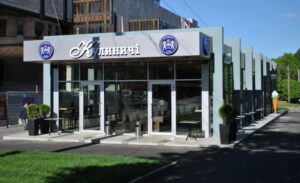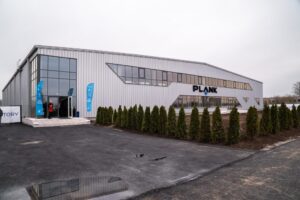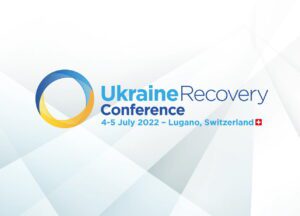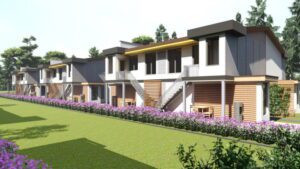
NJSC Naftogaz of Ukraine is implementing in Lviv, together with the city council, a project for the construction of a CHP plant on wood chips, which is planned to be put into operation by February 2023.
“I am sure that by February the CHPP will be operational. It will take a few months instead of a year and a half. NAC helps with the implementation of this project both in financing and in development. several months,” Naftogaz head Yuriy Vitrenko said at a briefing during a visit to the Lviv region on Friday.
As the correspondent of “Energoreforma” reports, according to Vitrenko, the NAC, which is implementing a number of similar projects in Ukraine, is ready to support other cities in this direction. ‘We have an interest in investing in such projects in order to import less gas at enormous prices. The implementation of such projects is beneficial both economically and in terms of ecology,” Vitrenko explained.
At the same time, he noted that both the Lviv authorities and the NAC itself also have a number of agreements in order “to then attract funds from IFIs for such projects.”
Lviv Mayor Andriy Sadovoy noted that this would be the city’s first powerful thermal power plant running on alternative fuels, which would cover about a quarter of its heat needs. “We planned such a project with the EBRD for a long time, but according to their classical procedures, we could only start it next year. But the Russian aggression intensified the thought process so much that we came to an agreement with Naftogaz,” Sadovoy explained.
According to him, the participation of the national company, which is the market leader, gives more opportunities and priorities, including in obtaining equipment.

LLC “Kulinichi” (Kharkiv region), a major manufacturer of bread and bakery products, has begun construction of a bakery in the Lviv region with a capacity of up to 150 tons of bread per day, part of which will be sold for export, according to the Ukrainian diplomat’s Facebook page Mikhail Bno-Ayriyan.
At the same time, it is specified that investments in the enterprise will amount to EUR 20 million over two years, part of the equipment for the plant will be transported from the Kulinichi plant in the Kharkiv region.
In turn, the bread manufacturer on his official Facebook page confirmed that he had begun construction of an enterprise in the Lviv region, but stressed that this did not mean the closure of the plant in the Kharkiv region.
“Yes, we are really building a new plant near Lviv. We are not closing the plant in Kharkiv, we are not closing our retail outlets in Kharkiv (…) We will bake bread for you, no matter what,” the Kulinichi page says in social network.
LLC “Kulinichi”, operating in Ukraine since 1995, unites 8 bakeries of the Kharkiv region and plants of the Poltava, Donetsk and Kyiv regions.
Since 1999, LLC has been cooperating with the Slovenian enterprise Gostol-Gopan.

The construction of another plant began in the Bila Tserkva industrial park (Kyiv region), the launch is scheduled for November 1, UFuture founder Vasyl Khmelnytsky told Interfax-Ukraine.
“During the war, we felt a big request from Ukrainian manufacturers from the regions to relocate to the Bila Tserkva industrial park. They have an alternative – moving to the EU, but it is important for the economy to leave producers in the country: these are taxes, jobs and development. Today we’ve started the construction of a new modern facility for a plant on 4,000 sq m. The amount of investment will be approximately $2 million,” he said.
Khmelnytsky added that this project will be the company’s record for the speed of construction.
“Already on November 1, we will launch production there. Now we are negotiating with several applicants from Mykolaiv and Kharkiv,” Khmelnytsky said.
UFuture holding company of businessman Khmelnytsky, as part of a business strategy in 2022, planned to expand the number of production facilities in Bila Tserkva industrial park from five to 11. Earlier, in an interview with the Interfax-Ukraine agency, he said that 11,000 sq m of industrial premises will be built in this park for the relocation of enterprises, the estimated investment is $6.5 million. In general, the entrepreneur announced plans the construction of 30 factories in Bila Tserkva.

The State Inspectorate for Architecture and Urban Planning of Ukraine processed over 16,000 requests from customers during the period of martial law, its press service reported.
“It is too early to talk about the restoration of the pre-war pace of construction, there are areas where it is not being carried out at all, however, we note a positive trend towards intensifying construction compared to previous months,” the inspectorate said in a Facebook post.
According to it, for the period from March 15 to July 15, the chief inspectors of the construction supervision processed 5,700 messages about the start of construction work and 420 permits for their implementation, as well as 8,900 declarations about the readiness of the facility for operation (including amnesty), and 344 certificates of acceptance of the object into operation. At the same time, 1,300 changes were made to messages, declarations and permits.
The inspectorate notes that most of the applications for the acceptance of objects into operation during martial law came from Kyiv region. At the same time, customers from Lviv, Kyiv, Khmelnytsky regions most actively applied for a permit for construction work.
According to it, a significant part of the issued construction permits relate to the overhaul or reconstruction of social infrastructure facilities, especially medical facilities. Among the applications received for new construction: a sheet glass plant in Kyiv region, a kindergarten-nursery in Dnipropetrovsk region, a water park in Zakarpattia regions, etc.

On July 4, an international conference for the restoration of Ukraine started in Lugano, Switzerland. Among the main decisions taken on the first day of the conference, one can single out the approval of a plan to provide Ukraine with macro-financial assistance in the amount of $750 billion. Of this total, from 150 to 250 billion is expected to be directed to the restoration of infrastructure and housing damaged as a result of hostilities.
At the same time, the mechanisms for the practical implementation of this project remain unclear in the context of the ongoing war and the need to adapt legislation to it and establish partnerships between the state and private companies. Portal Open4business turned to Igor Stakovychenko, an expert in the field of construction and real estate, for a comment.
In his opinion, the practical implementation of the project should be started now at all levels, since delaying the process can lead to negative consequences in the autumn-winter period.
“Mechanisms for allocating funds from the confiscated assets of the Russian Federation and its large businesses are already being implemented by individual countries. We, in turn, need to implement the conversion of these financial assets into specific infrastructure and construction projects by creating representative offices in donor countries and coordination centers in Ukraine,” said Ihor Stakovychenko.
The expert also stressed that the regional principle of recovery, now promoted by the country’s leadership, when a separate partner state is engaged in projects in a separate Ukrainian region, is the most effective at this stage.
In addition, Igor Stakovychenko suggested creating a system of decentralized funding for the implementation of individual projects at the local level.
“But we must not forget about our responsibility to our partners. It is necessary not only to minimize, but to completely exclude the possibility of misuse of foreign aid by local officials. To do this, it is necessary to create a separate trust fund for each individual restoration project, the activities of which will be as transparent and controlled as possible by both the Ukrainian anti-corruption authorities and the donor country,” Ihor Stakovychenko emphasized.
According to the expert, the basis for the creation of such funds should be existing budget programs, as well as amendments to the main financial document.
“In fact, now we can receive funds both in the form of direct assistance and in the form of investments from partners. Here it is important to successfully implement and present the first major restoration projects, which will help increase investment attractiveness even in the current conditions,” added Igor Stakovychenko.
CONSTRUCTION, EXPERT, FINANCE, MARKETS, REAL ESTATE, RESTORATION_OF_UKRAINE, TECHNOLOGY, ІГОР_СТАКОВИЧЕНКО, СТАКОВИЧЕНКО

On July 1, the “Register of Destruction” is launched in Ukraine. With its help, homeowners whose houses and apartments were damaged as a result of hostilities and enemy shelling will be able to apply for compensation using the Diya application.
At the same time, the question of what the restored houses of Ukrainians will be like, taking into account the new realities and requirements for the housing stock after the war, remains no less important. The Open4business portal discussed these issues with Igor Stakovichenko, an expert in the field of construction and real estate.
“The introduction of the “Register of Destruction” will greatly simplify the procedure for compensating for damages for affected citizens. In fact, such a registry will bring together all the data on the destruction in the country. This will be very useful both for the state of Ukraine and for individual citizens when receiving compensation from the aggressor through international legal institutions,” the expert noted.
As for the new technologies that will be used in the construction of housing, here Stakovichenko recommends first of all to focus on the needs of society.
“What most people want from a new home, whose homes have been destroyed by the war, is reliability and security. The presence of equipped bomb shelters, convenient evacuation routes, autonomy – these are the criteria without which it is difficult to imagine post-war architecture,” Igor Stakovichenko stressed.
In his opinion, a good option would be the restoration and development of numerous recreational areas, some of which were abandoned even before the war. Stakovichenko believes that many Soviet-built sanatoriums and boarding houses, which have been practically not used for all the years of independence, can become a good platform for building eco-friendly settlements with autonomous service, since most of the communications have already been connected to them.
“Environmental friendliness and high technologies during construction will also become the hallmark of post-war architecture in Ukraine. Projects such as “zero energy houses”, or even “mini-power houses”, which are now being widely implemented in the EU, will also be popular after the war,” the expert added.
At the same time, Igor Stakovichenko sees no special prospects for aggressive development in the central areas of large cities, which was practiced before the war.
“Multi-apartment residential complexes in large cities will certainly continue to be built, but whether there is a buyer for such housing is already a question. I think many have already revised or will reconsider their views on comfortable housing as a result of the war,” the expert concluded.
CONSTRUCTION, EXPERT, FINANCY, IGOR STAKOVYCHENKO, MARKETS, REAL ESTATE, TECHNOLOGY, СТАКОВИЧЕНКО